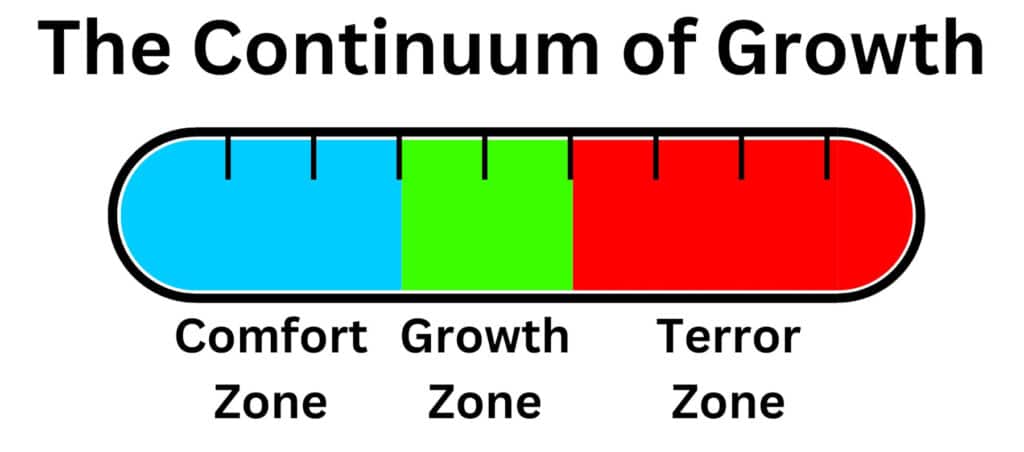Learning new things can be scary. Some things are more scary to learn than others. Swimming is the number 1 skill on some people’s list of things that are scary to learn. There are few things that most people learn to do that can save their lives. Swimming is one of them!
Swimming truly is a life saving skill, which can make it scary to learn. Some people can easily get scared while learning to swim because swimming puts you in life-threating situations. That can be especially spooky to young children who have never felt that type of fear. We don’t want fear to stop our vision of “A Drowning-Free Knoxville“.
That is why we developed the Continuum of Growth.
The Continuum of Growth is simply a framework for recognizing and managing fear.

Look at the picture. There are three different sections that are all a different color. The left side is the beginning and represents the easiest swimming skills, such as getting your face wet. As the scale moves to the right, the difficulty of the skill and the amount of fear associated with that skill increases.
The blue represents calm, which is the color of the Comfort Zone. The Comfort Zone is all the skills that someone is completely comfortable performing. Some people have no skills in the Comfort Zone. Some people have the entire continuum as their Comfort Zone. Everyone comes into swim lessons at different starting places, and that is okay.
The green represents “Go!”, which is the color of the Growth Zone. The Growth Zone is one or two skills above what someone already knows that may make them uncomfortable, but do not make them deathly afraid. Nervousness is a part of learning new things. Many times, if someone is nervous, that is a good sign. That means they are doing something they have never done before, which is learning!
The red represents danger and fear, which is the color of the Terror Zone. The Terror Zone is the skill and anything harder that would put someone into utter fear, the flight or fight response. What makes swimming so hard for so many people is that they cannot “fight or flight” in the water. “Fighting” only makes it worse, and there is no possibility of “flying” because you can’t swim to escape. Do you see why swimming is so scary for so many people? In the Terror Zone, instinctual mechanisms to respond to danger can’t fulfill their functions. That quickly leads to sheer terror.
The sizes of the Zones change as swim lessons progress. As students learn new skills, their Comfort Zone increases, the Terror Zone decreases, and the Growth Zone stays about the same size. The Comfort Zone increases because they have mastered new skills and are now comfortable doing them. The Terror Zone decreases because they have pushed beyond what they could previously do, which reduces the number of skills that makes them afraid. The Growth Zone stays the same size because the student can only do one, maybe two skills above what they know before they would enter the Terror Zone.
The goal is that the entire Contiuum is blue because the student has mastered all the swimming skills in our curriculum, which means they are comfortable doing what was once difficult and possibly scary.
This framework allows our instructors to decipher what zone the student is in while taking swim lessons. During a student’s first lesson, the instructor does an evaluation to see what skills they can already perform in their Comfort Zone. With that information, the instructor can see where their Growth Zone is as well. The goal is to NEVER put a student in the Terror Zone. EVER!
If an instructor sees signs of a student moving into the Terror Zone, they are trained to recognize and respond to that by pulling back to see what previous skills may need to be reviewed.
One of the most difficult parts about being a swim instructor is knowing how the signs of Terror Zone look different for every student. For many students, Terror Zone looks like screaming, crying, or trying to run away, which are obvious. When that happens, the instructor immediately stops to evaluate what is going on with the student.
For other students, they just get wide-eyed, they simply stop talking, they go limp, they laugh, they silently look at their parents, or many other more subtle signs. This requires the same response. If an instructor misses the sign and attempts to perform the skill anyway, the student might have a hard time trusting the instructor or trying the skill again. That is one reason it is so important to have this framework.
Similarly, everyone’s Growth Zone looks different. Most kids show typical signs of nervousness in the Growth Zone, such as whimpering, asking to do something else, or saying “I’m scared”. However, some students will scream and cry even in their Growth Zone. That doesn’t necessarily mean the instructor should avoid the skill, but the instructor should proceed with caution. If the student escalates further when attempting the skill, that is a sign they are being pushed into the Terror Zone.
Also, every student’s Continuum of Growth is slightly different. An adventurous student may have an entirely blue Continuum, which means nothing makes them scared! Their instructor will only have to figure out what skills they lack and teach them from there. A more anxious student may have a growth zone that is so small that a skill needs to be broken down into many parts to move that skill into the Comfort Zone. We hope this helps you understand our framework for understanding and dealing with fear.
If you have any questions, feel free to contact us at drowningfree@allknoxswim.com or 865-309-4944.
